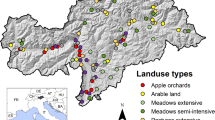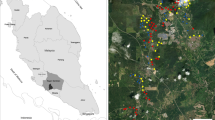Abstract
The dramatic loss of biodiversity in agricultural landscapes poses a substantial challenge to conservation. Losses are mainly caused by an all-pervasive intensification of agricultural management over recent decades, negatively affecting a wealth of taxa including insects. Against this background, we here set out to quantify the effects of grassland management on butterflies, comprising an important indicator and pollinator group. We recorded butterflies along 47 transects in the Westerwald mountain range, western Germany, spanning an intensification gradient ranging from grassland fallows via traditionally and intensively managed hay meadows through to silage grasslands. The numbers of species, individuals, threatened species, individuals of threatened species, and additionally α-diversity and conservation value were highest on traditionally managed grasslands followed by fallows, intensively managed grasslands, and finally silage grasslands. Comparing traditionally managed with silage grasslands, losses amounted on average to 44% of species, 58% of individuals, 75% of threatened species, and 90% of individuals of threatened species. Overall, the conservation value as an integral indicator decreased by 86%. Our study indicates a near linear decrease in biodiversity with increasing management intensity (mowing frequency, fertilization), while fallows also comprised valuable butterfly habitat. This study exemplifies the dramatic loss of insects in agricultural landscapes through intensification, and highlights the value of traditionally managed grasslands but also fallows.

Similar content being viewed by others
References
Allen-Wardell G, Bernhardt P, Bitner R et al (1998) The potential consequences of pollinator declines on the conservation of biodiversity and stability of food crop yields. Conserv Biol 12:8–17
Bauerfeind SS, Fischer K (2005) Effects of adult-derived carbohydrates, amino acids and micronutrients on female reproduction in a fruit-feeding butterfly. J Insect Physiol 51:545–554
Benton TG, Bryant DM, Cole L, Crick HQP (2002) Linking agriculture practice to insect and bird populations: a historical study over three decades. J Appl Ecol 39:673–687
BfN (Bundesamt für Naturschutz) (2011) Rote Liste gefährdeter Tiere, Pflanzen und Pilze Deutschlands. Nat Biol Vielfalt 70(3):1–716
Biesmeijer JC, Roberts SPM, Reemer M, Ohlemüller R, Edwards M, Peeters T, Schaffers AP, Potts SG, Kleukers R, Thomas CD, Settele J, Kunin WE (2006) Parallel declines in pollinators and insect-pollinated plants in Britain and the Netherlands. Science 313:351–354
Brooks TM, Mittermeier RA, Mittermeier CG, Da Fonseca GAB, Rylands AB, Konstant WR, Flick P, Pilgrim J, Oldfield S, Magin G, Hilton-Taylor G (2002) Habitat loss and extinction in the hotspots of biodiversity. Conserv Biol 16:909–923
Broyer J, Pelloli L, Curtet L, Chazal R (2017) On habitat characteristics driving meadow passerine densities in lowland hay-meadow systems in France. Agric Ecosyst Environ 237:24–30
Butler SJ, Boccaccio L, Gregory RD, Vorisek P, Norris K (2010) Quantifying the impact of land-use change to the European farmland bird populations. Agric Ecosyst Environ 137:348–357
Cardinale BJ, Duffy JE, Gonzalez A, Hooper DU, Perrings C, Venail P, Narwani A, Mace GM, Tilman D, Wardle DA, Kinzig AP, Daily GC, Loreau M, Grace JB, Larigauderie A, Srivastava DS, Naeem S (2012) Biodiversity loss and its impact on humanity. Nature 486:59–67
Cattin MF, Blandenier G, Banasek-Richter C, Bersier LF (2003) The impact of mowing as a management strategy for wet meadows on spider (Araneae) communities. Biol Conserv 113:179–188
Cizek O, Zamecnik J, Tropek R, Kocarek P, Konvicka M (2012) Diversification of mowing regime increases arthropods diversity in species-poor cultural hay meadows. J Insect Conserv 16:215–226
Donald PF, Green RE, Heath MF (2001) Agricultural intensification and the collapse of Europe’s farmland bird populations. Proc R Soc Lond B 268:25–29
Donald PF, Sanderson FJ, Burfield IJ, van Bommel FPJ (2006) Further evidence of continent-wide impacts of agricultural intensification on European farmland birds, 1990–2000. Agric Ecosyst Environ 116:189–196
Durán AP, Duffy JP, Gaston KJ (2014) Exclusion of agricultural lands in spatial conservation prioritization strategies: consequences for biodiversity and ecosystem service representation. Proc R Soc Lond B 281:20141529
Erhardt A (1985) Diurnal Lepidoptera: sensitive indicators of cultivated and abandoned grassland. J Appl Ecol 22:849–861
Fischer K (1997) Fauna und Flora des Westerwaldes: zur naturschutzfachlichen Bedeutung einer Mittelgebirgsregion. Pollichia 35:21–35
Fischer K, Busch R, Fahl G, Kunz M, Knopf M (2013) Habitat preferences and breeding success of Whinchats (Saxicola rubetra) in the Westerwald mountain range. J Ornithol 154:339–349
Fischer K, Fiedler K (2000) Response of the copper butterfly Lycaena tityrus to increased leaf nitrogen in natural food-plants: evidence against the nitrogen limitation hypothesis. Oecologia 124:235–241
Fischer K, O’Brian DM, Boggs CL (2004) Allocation of larval and adult resources to reproduction in a fruit-feeding butterfly. Funct Ecol 18:656–663
Flynn DFB, Gogol-Prokurat M, Nogeire T, Molinari N, Richers BT, Lin B, Simpson N, Mayfield M, DeClerck F (2009) Loss of functional diversity under land use intensification across multiple taxa. Ecol Lett 12:22–33
Görn S, Dobner B, Suchanek A, Fischer K (2014) Assessing human impact on fen biodiversity: effects of different management regimes on butterfly, grasshopper, and carabid beetle assemblages. Biodivers Conserv 23:309–326
Görn S, Fischer K (2011) Niedermoore Nordostdeutschlands bewerten: Vorschlag für ein faunistisches Bewertungsverfahren. Naturschutz Landschaftsplanung 43:211–217
Habel JC, Segerer A, Ulrich W, Torchyk O, Weisser WW, Schmitt T (2016) Butterfly community shifts over two centuries. Conserv Biol 30:754–762
Habel JC, Ulrich W, Biburger N, Seibold S, Schmitt T (2019) Agricultural intensification drives butterfly decline. Insect Conserv Divers 12:289–295
Hallmann CA, Sorg M, Jongejans E, Siepel H, Hofland N, Schwan H, Stenmans W, Müller A, Sumser H, Hörren T, Goulson D, De Kroon H (2017) More than 75% decline over 27 years in total flying insect biomass in protected areas. PLoS ONE 12:e0185809
Kearns CA, Inouye DW, Waser NM (1998) Endangered mutualisms: the conservation of plant-pollinator interactions. Annu Rev Ecol Syst 29:83–112
Kühn E, Musche M, Harpke A, Feldmann R, Metzler B, Wiemers M, Hirneisen N, Settele J (2014) Tagfalter-Monitoring Deutschland – Anleitung für Transektzähler. Oedippus 27:1–47
Kumaraswamy S, Kunte K (2013) Integrating biodiversity and conservation with modern agricultural landscapes. Biodivers Conserv 12:2735–2750
Kurze S, Heinken T, Fartmann T (2018) Nitrogen enrichment in host plants increases the mortality of common Lepidoptera species. Oecologia 188:1227–1237
Maes D, Van Dyck H (2001) Butterfly diversity loss in Flanders (north Belgium): Europe's worst case scenario? Biol Conserv 99:263–276
Marini L, Fontana P, Scotton M, Klimek S (2008) Vascular plant and Orthoptera diversity in relation to grassland management and landscape composition in the European Alps. J Appl Ecol 45:361–370
Maxwell SL, Fuller RA, Brooks TM, Watson JE (2016) Biodiversity: the ravages of guns, nets and bulldozers. Nature 536:143–145
Naeem S, Duffy JE, Zavaleta E (2012) The functions of biological diversity in an age of extinction. Science 336:1401–1406
Öckinger E, Eriksson AK, Smith HG (2006) Effects of grassland abandonment, restoration and management on butterflies and vascular plants. Biol Conserv 133:291–300
Pimm SL, Jenkins CN, Abell R, Brooks TM, Gittleman JL, Joppa LN, Raven PH, Roberts CM, Sexton JO (2014) The biodiversity of species and their rates of extinction, distribution, and protection. Science 344:1246752
Rada S, Schweiger O, Harpke A, Kühn E, Kuras T, Settele J, Musche M (2019) Protected areas do not mitigate biodiversity declines: a case study on butterflies. Divers Distrib 25:217–224
Sabel K-J, Fischer E (1992) Boden- und vegetationsgeographische Untersuchungen im Westerwald. Frankfurter geowiss. Arbeiten D 7:1–268
Sala OE, Chapin FS, Armesto JJ, Berlow E, Bloomfield J, Dirzo R, Huber-Sanwald E, Huenneke LF, Jackson RB, Kinzig A, Leemans R, Lodge DM, Mooney HA, Oesterheld M, Poff NL, Sykes MT, Walker BH, Walker M, Wall DH (2000) Biodiversity - global biodiversity scenarios for the year 2100. Science 287:1770–1774
Sawchik J, Dufrêne M, Lebrun P (2005) Distribution patterns and indicator species of butterfly assemblages of wet meadows in southern Belgium. Belg J Zool 135:43–52
Schmidt A (2014) Rote Liste der Grossschmetterlinge in Rheinland-Pfalz. Ministerium für Umwelt. Landwirtschaft, Ernährung, Weinbau und Forsten Rheinland-Pfalz, Mainz
Schuch S, Wesche K, Schaefer M (2012a) Long-term decline in the abundance of leafhoppers and planthoppers (Auchenorrhyncha) in Central European protected dry grasslands. Biol Conserv 149:75–83
Schuch S, Bock J, Krause B, Wesche K, Schaefer M (2012b) Long-term population trends in three grassland insect groups: a comparative analysis of 1951 and 2009. J Appl Entomol 136:321–331
van Strien AJ, van Swaay CAM, van Strien-van Liempt WTFH, Poot MJM, WallisDeVries MF (2019) Over a century of data reveal more than 80% decline in butterflies in the Netherlands. Biol Conserv 234:116–122
Socher SA, Prati D, Boch S, Müller J, Klaus VH, Hölzel N, Fischer M (2012) Direct and productivity-mediated indirect effects of fertilization, mowing and grazing on grassland species richness. J Ecol 100:1391–1399
Soons MB, Hefting MM, Dorland E, Lamers LPM, Versteeg C, Bobbink R (2017) Nitrogen effects on plant species richness in herbaceous communities are more widespread and stronger than those of phosphorus. Biol Conserv 212:390–397
Stevens CJ, Duprè C, Dorland E, Gaudnik C, Gowing DJG, Bleeker A, Diekmann M, Alard D, Bobbink R, Fowler D, Corcket E, Mountford JO, Vandvik V, Aarrestad PA, Muller S, Dise NB (2010) Nitrogen deposition threatens species richness of grasslands across Europe. Environ Pollut 158:2940–2945
Sumpich J, Konvicka M (2012) Moths and management of a grassland reserve: regular mowing and temporary abandonment support different species. Biologia 67:973–987
Tilman D, Fargione J, Wolff B, D’Antonio C, Dobson A, Howarth R, Schindler D, Schlesinger WH, Simberloff D, Swackhamer D (2001) Forecasting agriculturally driven global environmental change. Science 292:281–284
Van Dyck H, van Strien AJ, Maes D, van Swaay CAM (2009) Declines in common, widespread butterflies in a landscape under intense human use. Conserv Biol 23:957–965
Van Swaay C, Warren M, Loïs G (2006) Biotope use and trends of European butterflies. J Insect Conserv 10:189–209
Vogel G (2017) Where have all the insects gone? Science 356:576–579
Wallis de Vries MF, Van Swaay CA (2006) Global warming and excess nitrogen may induce butterfly decline by microclimatic cooling. Glob Change Biol 12:1620–1626
Westerwaldkreis (2018) 7. Umweltbericht des Westerwaldkreises. Kreisverwaltung des Westerwaldkreises
Wilson JD, Evans AD, Grice PV (2009) Bird conservation and agriculture. Cambridge University Press, New York
Acknowledgements
We are indebted to the farmers and landowners for tolerating our presence on their property.
Author information
Authors and Affiliations
Contributions
IH and KF designed the study, IH performed the field work, KF analysed the data with help from IH, IH and KF wrote the manuscript
Corresponding author
Ethics declarations
Conflict of interest
The authors declare that they have no conflict of interest.
Research involving human and animal participants
To obtain the data presented in the manuscript it has been necessary to involve animals. However, no individuals were removed from the field or killed. No human participants were involved in the work.
Informed consent
All authors consent to submission of this manuscript.
Additional information
Publisher's Note
Springer Nature remains neutral with regard to jurisdictional claims in published maps and institutional affiliations.
Electronic supplementary material
Below is the link to the electronic supplementary material.
Rights and permissions
About this article
Cite this article
Hannappel, I., Fischer, K. Grassland intensification strongly reduces butterfly diversity in the Westerwald mountain range, Germany. J Insect Conserv 24, 279–285 (2020). https://doi.org/10.1007/s10841-019-00195-1
Received:
Accepted:
Published:
Issue Date:
DOI: https://doi.org/10.1007/s10841-019-00195-1




